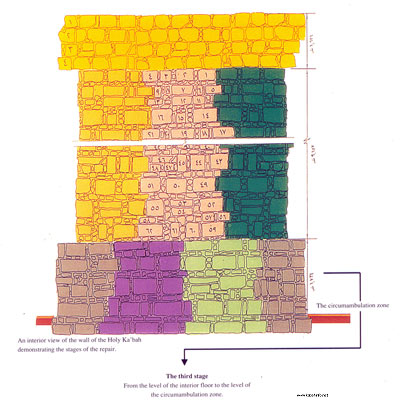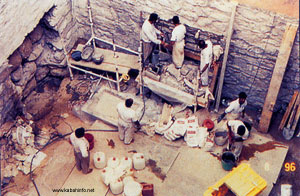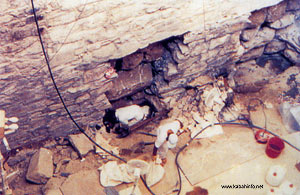>
Why the Renovation Work Stopped at the Bases
It is only natural in the complete architectural renovation of any building that an evaluation of the condition of the foundations is vital. The form of evaluation differs from one case to another. The Holy Ka'bah, being a holy site based on Divine Foundations, had to be evaluated by entirely different standards. The form of examination, therefore, had to be based on methods which do not compromise the sanctity, dignity and honour of the Sacred House.
The Condition of the Walls
Under the Level of the
Present CircumambulationZone, and the Condition of the Bases of the Foundations
To determine the condition of the walls at the bottom of the present circumambulation zone, two exploratory pits were dug near the walls; one at a distance of two metres from the Shami Corner, situated between it and the Yemeni Corner, the other at a distance of 2.10 metres, between the corner of the Black Stone and the Yemeni Corner. The following findings were recorded:
The First Pit
Dimensions: 1.10 metres parallel to the wall, and one metre perpendicular to the wall with an average depth of 1.40 metres from the present level of circumambulation of the Holy Ka'bah.
Observation: It was found that the base was made up of three to four layers of strong stones, resembling those of the upper walls. These stones were fitted one over the other without any mortar between the rows (this was practised in the original building of the walls). Those rows extend further inward than the upper walls built upon them.
The Second Pit
Dimensions: 1.10 metres parallel to the wall, and 1.05 metres perpendicular to the wall with an average depth of 1.25 metes below the level of circumambulation of the Holy Ka'bah.
Observation: It was evident that below the renovation were between four and five layers of the solid stones, resembling those of the upper wall. These stones were fitted one over the other without any mortar between the rows. A projection from the thickness of the upper wall was observed.



|
